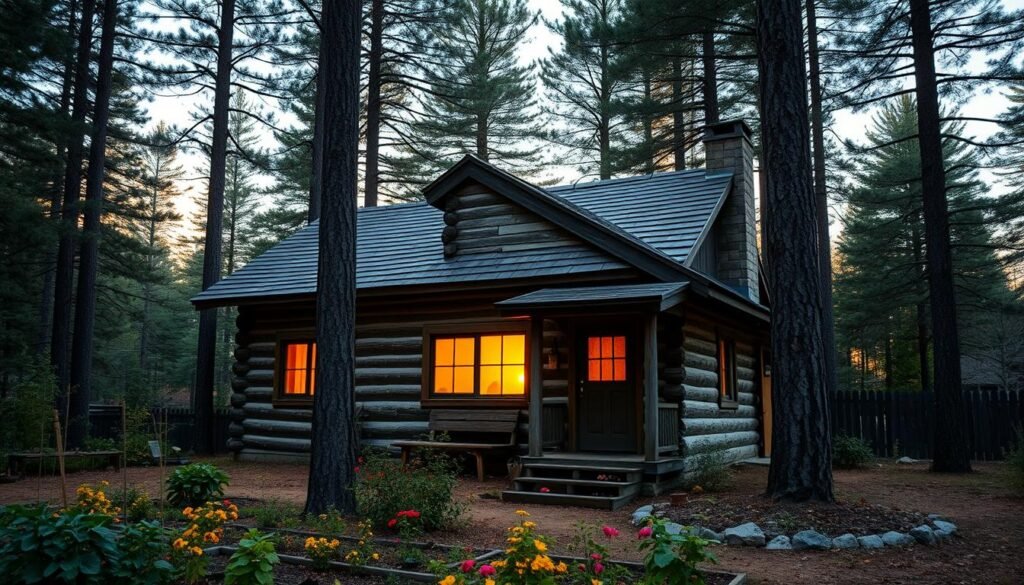Essential Factors for Selecting Ideal Bug-Out Sites
Surprising fact: nearly 60% of people underestimate how long they might need a secondary refuge after a major disaster.
Your bug location is a planned refuge you use when you must leave home to stay safe. Think of it as a place to stay as long as necessary, not just overnight.
An ideal site sits near reliable water, stays well away from dense populations and busy roads, and offers multiple routes you can find without GPS. It should resist extreme weather, provide internal protection, and hold food, medical kits, and tools.
Accessibility, buffer space, water access, and long-term sustainability are the core factors that separate a decent spot from one that fails when you need it most. Proper planning today leads to better outcomes later—bookmark this guide and return for updates.
Key Takeaways
- Define a durable secondary refuge, not a short-term stop.
- Prioritize nearby water, distance from people, and multiple access routes.
- Balance isolation with resupply options to avoid being cut off.
- Stage food, water, medical supplies, and tools for sustained independence.
- Include internal security and sanitation planning to reduce risk.
- Revisit and update your plan; this article will be refreshed regularly.
Start With a Survival Mindset and Plan You Can Execute Today
Your best tool in an emergency is a plan you can execute with limited time and tired people. Start small: set clear objectives, pick practical routes, and stage supplies so you act instead of freeze.
Proper planning and consideration: why your decisions now determine safety later
Proper planning turns vague worry into simple, repeatable steps. Train your household with short drills. Write routes and rally points so every person knows their role.
“A plan practiced once is worth more than ten untested ideas.”
Set your objective: family needs, duration, and realistic travel limits
Decide who you must protect, how long you expect to be away, and how far you can travel without exhausting your family. Consider vehicle and on-foot access in case highways are closed.
- Stage a bag for each person and check it regularly.
- Write alternate routes, rally points, and time estimates for each leg.
- Prep your home to be left safely and pre-stage your chosen location.
- Run low-stakes drills to make the plan a habit.
Bookmark this guide and return often; preppers update gear and advice as conditions change.
Choosing Bug-Out Sites: What Really Matters for Survival
Pick a place that fits likely emergencies in your region rather than chasing a theoretical perfect bug location.
Your chosen location should match the situations you expect—storms, infrastructure collapse, or civil unrest. Expect trade-offs: deep seclusion can limit resupply while proximity to towns raises exposure. Learn local weather patterns, neighbors, and likely threats so you can plan around them.
Key practical steps you can act on today:
- Identify likely emergency scenarios and pick the option that fits your family’s needs rather than an idealized fantasy.
- Prioritize travel time, terrain, seasonal weather, and nearby allies or risks when evaluating a bug location.
- Weigh seclusion versus access honestly: more isolation lowers visibility but can complicate resupply and care in your case.
- Confirm the place supports long-term needs—room for gardens, safe storage, medical space, and defensible approaches.
- Build familiarity with the land: note trails, choke points, and landmarks so you can navigate without tech.
“Choose the site that works with your plan, not the plan that forces you into a distant site.”
Access, Routes, and Escape: Reaching Your Location When Roads Fail
When highways jam or close, your route plan decides if you reach your bug location or get stranded. Build layered routes and test them before an emergency so you have real options when time matters.
Primary, secondary, and tertiary routes beyond highways
Create three tiers of routes that avoid choke points. Use main roads as a fast primary route, quiet secondary back roads, and tertiary service roads or trails if roads close.
Pre-run each way at different times to spot bottlenecks, low water crossings, and bridges that may fail in a disaster.
On-foot vs. vehicle access: distance, terrain, and fuel realities
Plan both vehicle and on-foot movements. A loaded bag slows you; count realistic miles per hour and fuel range for each vehicle.
Keep a ready vehicle kit and a compact bag so you can pivot quickly without scrambling gear.
Navigation without GPS: landmarks, maps, and local recon
Cache paper maps and mark landmarks. Walk local trails and note distinct features so you can navigate in low visibility or when cell networks fail.
“Every extra mile raises the chance of obstacles—choose routes that stay quiet and predictable.”
Buffer Space and Seclusion Without Cutting Off Resources
Give your site enough buffer so routine traffic and curious people miss your property entirely.
Buffer space reduces unwanted encounters and lowers the chance of random visitors during an emergency or long-term chaos.
Distance from towns and highways increases safety over time, but do not isolate so far that resupply or medical help becomes impossible.
Optimizing distance from population centers and main roads
Set a target buffer that keeps you out of routine travel corridors while preserving access to essentials. Use satellite views and simple drives to check sightlines and approach routes.
Map likely flows of people in crises and place your shelter off those paths. Think about ambient noise and light discipline so your area does not advertise activity at night.
Low-visibility siting and camouflage to “fly under the radar”
Position buildings where trees, ridgelines, and vegetation break direct sight from roads and air. Match exterior colors to the surroundings and avoid reflective surfaces.
Keep storage and shelter out of obvious lines-of-sight and maintain discreet access lanes that look unremarkable. Hide water access and minimize visible trails so individuals chasing resources pass by without finding your bug location.
- Balance seclusion with resupply practicality so your place supports survival past the first weeks.
- Use natural terrain and subdued colors to lower your signature and improve security.
- Plan access lanes and sightlines to reduce curiosity-driven encounters by people and other individuals.
“Fly low, resupply smart, and keep your activity quiet; safety grows from careful distance.”
Water Wins: Prioritize Reliable, Treatable Sources On-Site
A reliable freshwater source on-site removes one of the biggest risks when you leave home. Prefer areas with natural water—streams, rivers, lakes, or ponds—so you avoid long trips that expose you to weather and other people.
Evaluate streams, rivers, lakes, and ponds by season and flow
Check seasonal flow and freeze risk. Visit the area in wet and dry months to confirm year-round access.
Watch upstream land use to spot agricultural runoff or industrial hazards that can taint your source.
Purification and storage: filters, boiling, and tablets
Always purify before use. Use a gravity filter plus a compact pump, carry purification tablets, and have a boil routine.
Stage storage containers and rotate water so you cover several days if access freezes, floods, or is unsafe.
Site layout: keep sanitation and waste far from water
Map latrines, composting toilets, and trash pits downhill and well away from any water you rely on.
Plan access paths that reduce wildlife cross-traffic and keep your water source low-profile.
- Pick locations with dependable on-site water to cut risky resupply trips.
- Use multiple purification methods and store enough to cover several days.
- Include water in your supplies planning for drinking, cooking, and hygiene to support food and overall survival.
“Treat every drop; redundancy in purification and storage keeps your resources usable when weather or people threaten access.”
Shelter and Structure: Protection From Weather and People
Shelter choice shapes your day-to-day safety and your options when escape routes shrink. You must weigh speed against customization when picking a structure on your property or building new.
Existing buildings offer quick occupancy and utilities. New builds allow concealment and tailored layouts. Each option affects cost, time, and long-term safety.

Your trade-offs and key upgrades
Reinforce doors and windows with solid hardware and strike plates. Add locks that allow you to lock down from the inside.
Designate a safe room with hard cover, comms, and an independent power source. Insulate and ventilate so the shelter stays livable through extreme weather.
“Practical shelter design reduces exposure, buys time, and gives you real options when conditions change.”
- Harden storage with hidden compartments and tamper-evident seals.
- Position structures to avoid skyline exposure and use natural cover.
- Include fire protection, quiet power, and regular checks on doors and locks.
| Feature | Existing Building | New Structure | Why it matters |
|---|---|---|---|
| Speed to occupy | High | Low | Quick use reduces short-term risk |
| Concealment | Medium | High | Easier to blend into landscape |
| Customization | Limited | Flexible | Design for security and weather resilience |
| Cost & time | Lower, faster | Higher, longer | Balances budget against long-term safety |
Long-Term Sustainability: Food, Energy, and Supplies That Last
Plan long-term resources so your refuge supports people through seasons and shortages. Focus on sun, soil, and nearby water when evaluating any property as a long-term option.
Food production and local resources
Test soil and sunlight to design raised beds and perennial plantings that give dependable food. Add seed storage and preservation—drying and canning—to stretch harvests.
Survey wildlife and waterways to set realistic expectations for hunting and fishing yields across seasons.
Energy mixes and safe fuel
Mix wood and solar so you can heat and run essentials. Store fuel safely and limit generator use to critical tasks to preserve supplies.
Tools, supplies, and waste systems
Stage core tools and medical kits, plus spares for filters and batteries. Keep two-person carry bags ready for short resupply runs.
Use composting toilets or latrines placed well away from any water source to prevent disease and reduce odors.
“Redundancy in food, water, and power keeps your shelter useful when one option fails.”
| Need | Practical Option | Why it matters |
|---|---|---|
| Food | Garden beds, seed storage, hunting/fishing | Reduces dependence on outside resources |
| Energy | Wood heat, solar panels, safe fuel storage | Maintains essential systems in outages |
| Supplies | Tools, medical kits, water treatment spares | Prevents single-point failures |
| Waste | Composting toilet, structured routines | Prevents disease and limits scent signature |
Legal, Budget, and Property Considerations in the United States
Assess both cost and code: a promising location can become unusable if zoning or water rights block upgrades.
Start by confirming zoning, building, and water-use rules so improvements do not run afoul of state or local law.
Build a realistic budget that covers land, basic structures, water systems, and initial supplies. Leave room for staged upgrades.
Document a phased plan that adds security hardening, outbuildings, and energy in order as funds allow.
Decide if you will stay at home or use a remote bug location based on likely disasters in your region and your travel capabilities.
- Confirm tax issues, easements, and access rights before purchase.
- Keep deed, maps, permits, and contacts backed up in digital and hardcopy forms.
- Compare several options and pick the one that fits your priorities, not an idealized fantasy.
Coordinate with trustworthy neighbors when appropriate. Balance operational security with the benefits of mutual aid.
“There is no perfect site; prioritize and make compromises that keep your plan practical.”
Conclusion
Close this guide by committing to steady upgrades and short drills that keep your location usable over time. Start with a simple plan, stage a current bag, and clear the first tasks so you act fast in an emergency.
Accept trade-offs: improve your property in phases, protect water and sanitation, and keep multiple routes practiced. Consolidate checklists for food, energy, tools, and days of supplies so the plan works under pressure.
,Bookmark this article and return often. Calm planning now protects your people when chaos grows. The right place is the one you can reach, sustain, and keep off most peoples’ radar.
FAQ
How do you pick a site that matches likely emergencies and your bug-out plan?
Start by listing realistic scenarios for your area—storms, fires, grid failures, civil unrest. Rank them by likelihood and impact, then choose locations that mitigate top threats. For example, if wildfires are common, prioritize non-forested areas with defensible space. Match distance and travel time to your family’s mobility and vehicle fuel limits so you can reach the place under stress.
What are the most important access considerations when roads may be blocked?
Identify at least three routes: a primary road, a lesser-used secondary road, and an off-road option for foot or ATV travel. Scout those routes at different times and note choke points, bridges, and likely bottlenecks. Carry paper maps and practice navigating by landmarks so you can move without GPS.
How much distance should you aim for between your site and population centers?
Aim for a buffer that reduces traffic and attention but still allows reasonable resupply. For many people, 20–60 miles from major urban centers is a practical compromise. Adjust for local variables: in densely populated regions you may need more distance; in remote regions less.
What water features make a site reliable year-round?
Prefer perennial sources: year-round springs, reliable streams, or large lakes. Evaluate seasonal flow and upstream risks like contamination or diversion. Always plan for on-site storage and multiple treatment methods—gravity filters, ceramic filters, chemical tablets, and means to boil when feasible.
Should you favor existing structures or build new shelter on your site?
Existing buildings offer speed and weatherproofing but can have security or legal drawbacks. New structures give you control over layout and materials. Balance: secure a temporary existing option for the short term and phase in purpose-built shelter for long-term occupancy.
What renewable energy options work best for small-group long-term stays?
Solar paired with battery storage is scalable and low-maintenance for basic needs—lighting, comms, pumps. Wood-burning systems provide reliable heat and cooking if you have sustainable timber. Keep fuel backups like propane for essential appliances and plan for tool fuel (chainsaw, generator) as a contingency.
How do you plan food production for months to years on-site?
Prioritize diverse food sources: raised beds and heirloom seeds for vegetables, fruit trees for long-term calories, and protein via small livestock, poultry, fishing, or hunting. Rotate crops, invest in soil-building (compost and cover crops), and store a base of nonperishables to bridge the first seasons.
What sanitation measures prevent disease near water sources?
Site latrines and composting toilets downhill and at least 200 feet from water. Direct graywater away from wells and streams using vegetative filtration. Regularly manage compost piles and avoid raw sewage near crops. These steps protect your water and reduce illness risk.
What security features should you stage at a retreat to deter threats?
Use natural barriers—embankments, thorny planting, and layered sightlines—to slow intruders. Reinforce entry points with solid doors, quality locks, and the ability to lock down internal areas. Establish early-warning systems: motion-activated lights, perimeter alarms, and clear observation points.
How do legal and budget realities affect the choice of property in the United States?
Zoning, water rights, building permits, and access easements can limit options. Work with a real estate attorney and local county offices before buying. Budget for purchase, ongoing maintenance, taxes, and improvements; sometimes a smaller, legal property with good access beats an isolated parcel with uncertain rights.
How close should your bug-out bag and staged supplies be to your primary exit routes?
Keep a grab-and-go kit at home, one in your vehicle, and a compact set at a secondary rendezvous point. Staged supplies at the retreat should cover at least 30–90 days. Position key caches within a short walk of safe parking or drop points to avoid long, exposed carries.
What navigation tools should you practice using before an emergency?
Master topographic maps, a reliable compass, and route-planning using hand-drawn waypoint notes. Learn to read natural markers and the sun for direction. Practice drills during daylight and at night so you can move confidently without electronics.
How do you assess wildfire risk and create defensible space on a property?
Evaluate local vegetation, slope, and prevailing winds. Create fuel breaks by thinning trees, removing ladder fuels, and maintaining a noncombustible perimeter around structures. Use ember-resistant materials for roofs and clear at least 30 feet of reduced fuel area, expanding that when terrain warrants.
What are compact, high-impact tools and supplies to stage on-site first?
Prioritize water filtration, multi-fuel stoves, quality knives, a first-aid kit, spare batteries, a means to make fire, and seed storage. Add a solar charger, hand tools (axe, shovel), and durable tarps. These items let you establish shelter and basic systems quickly.
How do you balance seclusion with access to emergency help or resupply?
Choose a site that is discreet but not unreachable. Maintain good relations with nearby landowners for mutual aid, and plan periodic trips to town for resupply and intel. Distance should reduce attention, not eliminate the ability to get help in critical situations.


